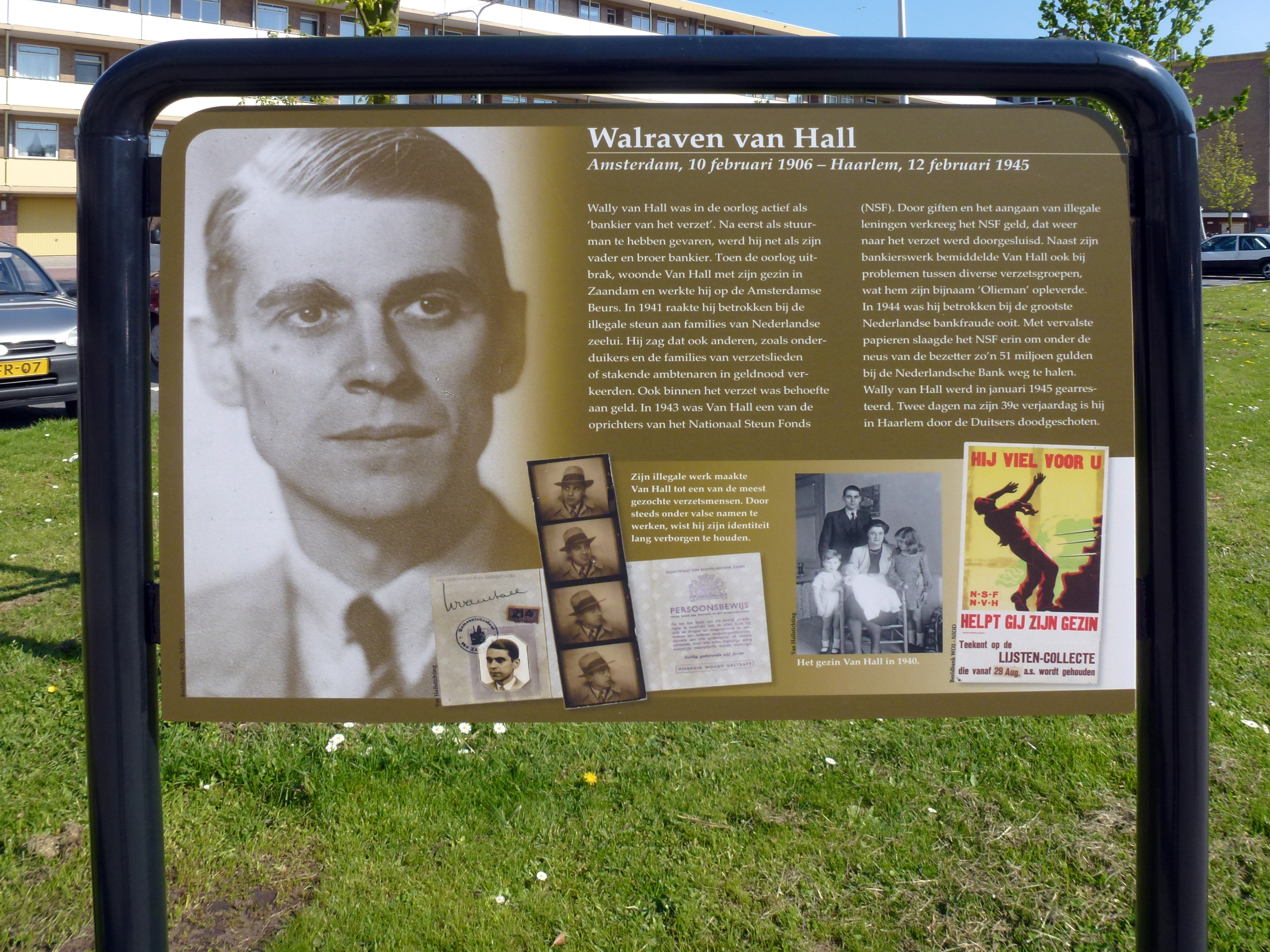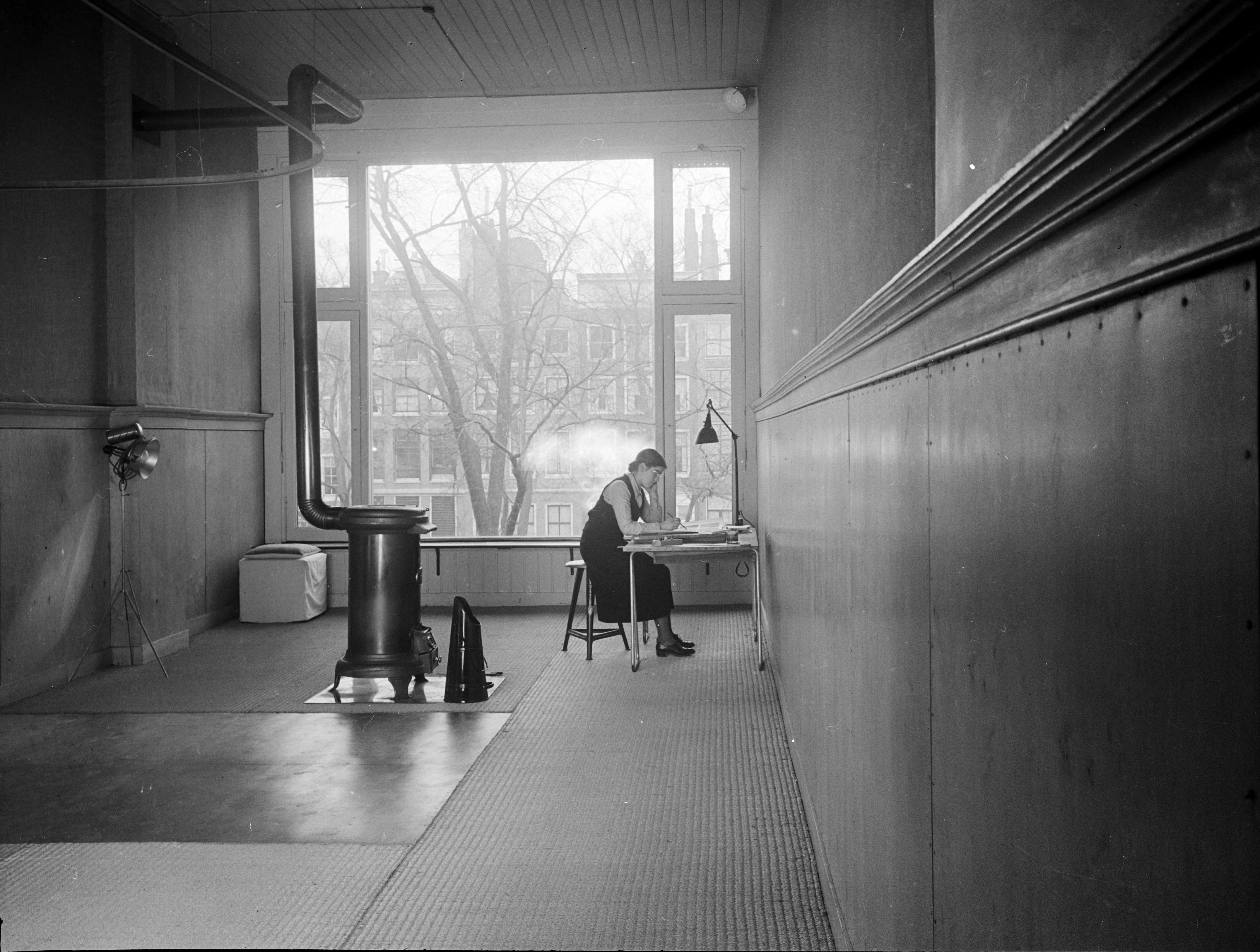|
Erebegraafplaats Bloemendaal
The Erebegraafplaats Bloemendaal, or Dutch Honorary Cemetery Bloemendaal, is a World War II final resting place in Zuid-Kennemerland National Park in Bloemendaal, Netherlands. Located on the top of a dune, it can be reached by a small path from a parking lot located near the provincial route between Overveen center and Zandvoort. None of the graves were originally located here. The cemetery is a final resting place for victims of the Nazi occupation who were executed in various places in the dunes. A total of 422 victims were found in 45 locations and of those, 347 have been laid to rest in 41 groups in Erebegraafplaats Bloemendaal. Nearby, nine locations of former group burials are marked with simple granite stones. The cemetery was first used on 27 November 1945 for the reburial of the Dutch resistance fighter Hannie Schaft, with a procession from the Grote Kerk, Haarlem. In 2010 the cemetery was awarded the Rijksmonument status. List of graves Some notable graves: ... [...More Info...] [...Related Items...] OR: [Wikipedia] [Google] [Baidu] |
Righteous Among The Nations
Righteous Among the Nations ( he, חֲסִידֵי אֻמּוֹת הָעוֹלָם, ; "righteous (plural) of the world's nations") is an honorific used by the State of Israel to describe non-Jews who risked their lives during the Holocaust to save Jews from extermination by the Nazis for altruistic reasons. The term originates with the concept of " righteous gentiles", a term used in rabbinic Judaism to refer to non-Jews, called , who abide by the Seven Laws of Noah. Bestowing When Yad Vashem, the Shoah Martyrs' and Heroes' Remembrance Authority, was established in 1953 by the Knesset, one of its tasks was to commemorate the "Righteous Among the Nations". The Righteous were defined as non-Jews who risked their lives to save Jews during the Holocaust. Since 1963, a commission headed by a justice of the Supreme Court of Israel has been charged with the duty of awarding the honorary title "Righteous Among the Nations". Guided in its work by certain criteria, the commission ... [...More Info...] [...Related Items...] OR: [Wikipedia] [Google] [Baidu] |
Cemeteries In North Holland
A cemetery, burial ground, gravesite or graveyard is a place where the remains of dead people are buried or otherwise interred. The word ''cemetery'' (from Greek , "sleeping place") implies that the land is specifically designated as a burial ground and originally applied to the Roman catacombs. The term ''graveyard'' is often used interchangeably with cemetery, but a graveyard primarily refers to a burial ground within a churchyard. The intact or cremated remains of people may be interred in a grave, commonly referred to as burial, or in a tomb, an "above-ground grave" (resembling a sarcophagus), a mausoleum, columbarium, niche, or other edifice. In Western cultures, funeral ceremonies are often observed in cemeteries. These ceremonies or rites of passage differ according to cultural practices and religious beliefs. Modern cemeteries often include crematoria, and some grounds previously used for both, continue as crematoria as a principal use long after the interment areas ... [...More Info...] [...Related Items...] OR: [Wikipedia] [Google] [Baidu] |
Johannes Post
Johannes Post (4 October 1906 – 16 July 1944) was a Dutch resistance leader during the Nazi occupation of the Netherlands. He helped lead part of the Landelijke Knokploegen and hid Jews in his village, Nieuwlande. Post was recognized as Righteous Among the Nations in 1965. Early life Johannes Post was born on October 4, 1906 in the village of Hollandscheveld. He was the eleventh and youngest child of Jan-Wolters Post and Trijntje Tempen. He attended primary school, and afterwards attended one year of Meer Uitgebreid Lager Onderwijs, MULO before going to work at his father's company. Post became a farmer in Nieuwlande, alongside being an alderman and councilor in the municipality of Oosterhesselen. He also worked trading eggs, poultry and horses. Post was a member of the Anti-Revolutionary Party (ARP). On November 26, 1929, Post married Dien Salomons (1903-1991), having nine children together. Beginning of World War II Post's planned to go to the west of the Netherlands dur ... [...More Info...] [...Related Items...] OR: [Wikipedia] [Google] [Baidu] |
Walraven Van Hall
Walraven "Wally" van Hall (10 February 1906 – 12 February 1945) was a Dutch banker and resistance leader during the occupation of the Netherlands in World War II. He founded the bank of the Resistance, which was used to distribute funds to victims of the Nazi occupation of the Netherlands and fund the Dutch resistance. Van Hall was executed by the German occupier in Haarlem shortly before the end of the war and buried at the Erebegraafplaats Bloemendaal. Early life Born into an influential Dutch family, Walraven van Hall initially studied to become an officer in the merchant marine, but after having worked for some years as third mate he was rejected because of his eyesight. Unable to work in the merchant marine, he moved to New York City in 1929. His brother, future Mayor of Amsterdam Gijs van Hall, who already worked at a bank, helped him get a job with a Wall Street firm. Having thus been introduced to banking, Walraven van Hall returned to the Netherlands and became ... [...More Info...] [...Related Items...] OR: [Wikipedia] [Google] [Baidu] |
Gerrit Van Der Veen
Gerrit van der Veen (26 November 1902, Amsterdam — 10 June 1944, Overveen) was a Dutch sculptor. He was a member of the Dutch underground, which resisted the German occupation of Amsterdam during World War II. The historian Robert-Jan van Pelt wrote: In 1940, after the German occupation, van der Veen was one of the few who re-fused to sign the so-called “Arierverklaring,” the Declaration of Aryan Ancestry. In the years that followed, he tried to help Jews both in practical and symbolic ways. Together with the musician Jan van Gilse and the (openly homosexual) artist, art historian, and critic Willem Arondeus, van der Veen established the underground organization De Vrije Kunstenaar (The Free Artist). Van der Veen and the other artists published a newsletter calling for resistance against the occupation. When the Germans introduced identity documents (Persoonsbewijzen) that distinguished between Jews and non-Jews, van der Veen, Arondeus and the printer produced some 8 ... [...More Info...] [...Related Items...] OR: [Wikipedia] [Google] [Baidu] |
Johan Limpers
Johan Limpers (2 August 1915, in Heemstede – 10 June 1944, in Overveen) was a Dutch sculptor. Limpers was a student of Jan Bronner at the Rijksakademie. His work followed the ideas of Jan Bronner and was monumental, for this he won the Dutch equivalent of the Prix de Rome in 1940. During the Second World War he was active in the resistance and took part in setting fire to the Amsterdam registration office in 1943. He was executed by a German firing squad at Overveen Overveen is a village in North Holland in the Netherlands, in the municipality of Bloemendaal. Overveen lies on the eastern fringe of the North Sea dunes. To the east it borders the built-up areas of Haarlem. A few kilometres to the west of the .... After the war he was reburied at the Eerebegraafplaats Bloemendaal. He was married with fellow member of the resistance and sculptor Katinka van Rood. 1915 births 1944 deaths Dutch resistance members Dutch sculptors Dutch male sculptors Prix de Rome ... [...More Info...] [...Related Items...] OR: [Wikipedia] [Google] [Baidu] |
Andries De Koning
Andries is a Dutch and Afrikaans masculine given name or surname equivalent to Andrew. Given name People with this name include * Andries van Artvelt (1590–1652), Flemish painter * Andries Beeckman (1628–1664), Dutch painter * Andries Bekker (born 1983), South African rugby player * Andries Benedetti (1615–1669), Flemish Baroque painter. * Andries Bicker (1586–1652), Dutch merchant, leader of the Arminians, and VOC administrator * Andries Boelens (1455–1519), Dutch mayor of Amsterdam * Andries Bonger (1861–1936), Dutch artist, brother-in-law of Vincent van Gogh * Andries Bosman (1621–1681), Flemish priest and painter, * Andries Both (1612–1642), Dutch genre painter * Andries Botha (c. 1800–c. 1870), South African leader of the Khoi people * Andries Botha (born 1952), South African artist and political activist * Andries Brink (1877–1947), South African military commander * Andries Brouwer (born 1951), Dutch mathematician and computer programmer * Andries ... [...More Info...] [...Related Items...] OR: [Wikipedia] [Google] [Baidu] |
Gerard De Koning
Gerard is a masculine forename of Proto-Germanic origin, variations of which exist in many Germanic and Romance languages. Like many other early Germanic names, it is dithematic, consisting of two meaningful constituents put together. In this case, those constituents are ''gari'' > ''ger-'' (meaning 'spear') and -''hard'' (meaning 'hard/strong/brave'). Common forms of the name are Gerard (English, Scottish, Irish, Dutch, Polish and Catalan); Gerrard (English, Scottish, Irish); Gerardo (Italian, and Spanish); Geraldo (Portuguese); Gherardo (Italian); Gherardi (Northern Italian, now only a surname); Gérard (variant forms ''Girard'' and ''Guérard'', now only surnames, French); Gearóid (Irish); Gerhardt and Gerhart/Gerhard/ Gerhardus (German, Dutch, and Afrikaans); Gellért ( Hungarian); Gerardas ( Lithuanian) and Gerards/Ģirts ( Latvian); Γεράρδης (Greece). A few abbreviated forms are Gerry and Jerry (English); Gerd (German) and Gert (Afrikaans and Dutch); Gerrit ( ... [...More Info...] [...Related Items...] OR: [Wikipedia] [Google] [Baidu] |
Dutch Cross Of Resistance
The Verzetskruis 1940–1945 (English: ''Cross of Resistance 1940–1945'') is a decoration for valour in the Netherlands. Instituted on May 3, 1946, it was awarded in recognition of the individual courage shown in resistance against the enemies of the Netherlands and for the maintenance of liberties. It is one of the highest decorations in the Netherlands. Before the Netherlands was liberated in May 1945, the Dutch government in London had developed a valid and balanced system of decorations, both civil and military. In addition to the existing Military Order of William, they were created new ones as the Bronze Lion, the Bronze Cross, the Cross of Merit and the Cross of the Flyer. But there was no valid award to reward members of resistance organizations, while neighboring countries had already filled this gap. As it was not agreed that the acts of the Resistance could be rewarded with an existing military decoration, it was decided to create a specific one. During t ... [...More Info...] [...Related Items...] OR: [Wikipedia] [Google] [Baidu] |
Paul Guermonprez
Paul Gustave Sidonie Guermonprez (1908–1944) was a Belgium–born Dutch photographer, graphic designer, and a Dutch resistance fighter during World War II. Early life and education Paul Guermonprez was born 28 December 1908 in Ghent, Belgium. His family fled during World War I, eventually resettling in the Netherlands. Guermonprez attended the De Suikerschool Amsterdam, after primary school. From 1929 to 1932, he worked on a sugar plantation in the Dutch East Indies (now Indonesia). In 1932, he attended Bauhaus Dessau in Germany before the schools closure, studying with photographer Walter Peterhans. In 1933, Guermonprez moved back to the Netherlands because of the rise in Nazi Germany. After moving to Amsterdam he worked as a Commercial artist, founded his advertising company ''Co-op 2'', and he taught classes at the recently established New Art School, Amsterdam (Nieuwe Kunstschool, Amsterdam). In 1939, he married textile artist Trude Guermonprez. Career and World War ... [...More Info...] [...Related Items...] OR: [Wikipedia] [Google] [Baidu] |






